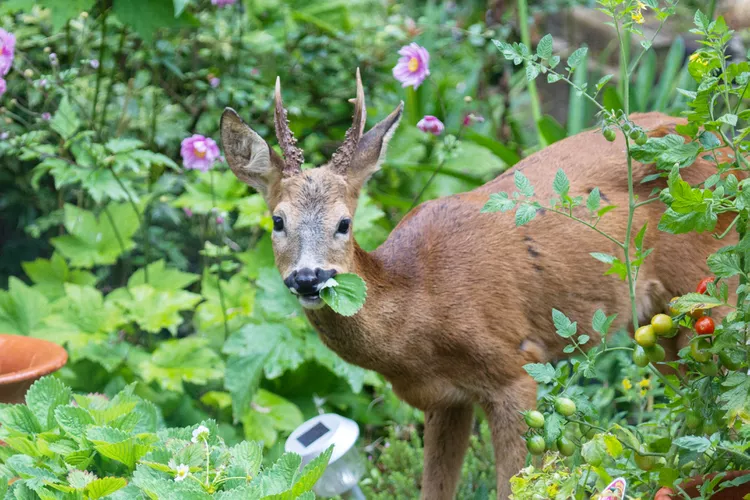Deer are a delight to watch from a distance, but when they‘re traipsing through your vegetable garden, you may find yourself wondering, "Do deer eat tomato plants?" And if these four-legged visitors start munching on your plants, delight is probably the last word on your mind. Many vegetables, along with favorite shrubs, perennials, and annual flowers can become a buffet for these voracious creatures. Learn how to identify deer damage on tomato plants and how to protect your crop.
Deer and Tomatoes
Vegetable gardens offer a tasty bounty for both humans and deer. As their native environment is increasingly taken up by housing developments, deer are forced into smaller and smaller habitats. They quickly become accustomed to suburban living and are drawn to vegetable gardens where the food sources are plentiful and nutritious.
Humans and deer also share many favorite edible plants, including beans, beets, broccoli, cabbage, lettuce, strawberries, and sweet corn. Tomatoes are notably not on the preferred plant list for deer, but these animals can be unpredictable and may take a few bites of pungent tomato foliage or ripe fruit if other food sources are limited.
Plant companion vegetables and herbs that deer rarely browse due to their prickly texture or pungent odor near tomato plants. These include chives, cucumbers, eggplant, leeks, onions, rosemary, rhubarb, and sage.
Identifying Deer Damage on Tomatoes
Tomato plants are susceptible to deer at any time during their development, from the seedling stage to harvest time. If your tomato plant is missing leaves or sporting damaged fruit, deer might be the cause. Begin by looking for deer tracks around your plants. Their cloven hoof prints are easy to spot.
Deer-damaged foliage has a rough, jagged edge because deer lack upper incisor teeth. They bite down on a leaf and pull, leaving behind a ragged remnant. Leaf damage caused by rodents, such as rabbits and chipmunks, has a regular, straight margin. Deer take a bite out of ripe tomatoes or eat whole fruit, depending on the size.
Peak feeding time is early morning and late evening. Although deer are rarely seen feasting in the garden, they usually leave behind plenty of evidence of their presence.
5 Ways to Protect Your Tomatoes from Deer
If you suspect deer have been snacking on your tomato plants, you may want to consider the following options for keeping the critters from wrecking your harvest.
1. Install a deer fence.
A fence is the best way to keep deer away from plants you don't want them to eat. Most traditional landscape fences won’t keep out deer. These large, agile creatures can easily jump a standard 4-foot-tall fence. Height is key to excluding deer from a large area such as an entire vegetable garden or backyard.
The best deer fence is 8 feet tall. Many commercial deer fence options are available, but they come with a high price tag. You can make your own 8-foot-tall deer fence by stacking two 4-foot widths of wire fencing on top of each other.
A well-built and regularly maintained electric fence can also serve as a deer barrier. An electric fence doesn’t need to be 8 feet tall to be effective; 4- to 5-foot-tall electric fences usually keep deer out.
2. Build a micro-enclosure.
Wildlife specialists have found that deer avoid entering small spaces. The animals perceive the small space as being too risky for fast entry and exit. Gardeners can use this to their advantage. Erect a standard 4-foot-tall fence around a tomato patch measuring no more than 16 feet long and 16 feet wide. Research has shown that deer are regularly deterred by the 16-foot square, leaving the plants growing inside alone.
3. Hang a bar of soap nearby.
If you are protecting a single tomato plant in a container or a small, raised bed, having a bar of very fragrant bath soap nearby can keep deer from browsing your tomatoes. Begin with the right soap for the job—an individually wrapped, highly fragrant small bar. Leave the bar wrapped and drill a small hole through the soap. Thread a piece of yarn or jute through the hole and hang the bar of soap on a stake near a tomato plant. If you have several tomato plants, place several bars of soap around the perimeter of the planting.
Deer tend to become accustomed to a strong scent over time, so switch your repellent of choice every few weeks to keep them from becoming too comfortable with a particular odor.
4. Spray the soil with a raw egg mixture.
Wildlife specialists have found that a raw egg slurry can effectively repel deer. To make it, mix a dozen raw eggs with 5 gallons of water and apply it to the soil around tomato plants with a sprayer. The eggs quickly rot in the ground, producing a putrid odor that is detected by deer but not by humans. Reapply the egg and water mixture after every rain.
5. Sprinkle the soil with bone meal and blood meal.
Typically used as soil enhancements, blood meal and bone meal have also proven helpful in repelling deer. Mix blood meal and bone meal together in a 1 to 1 ratio and sprinkle the dry product on the soil around tomato plants. Reapply after every rain.




















